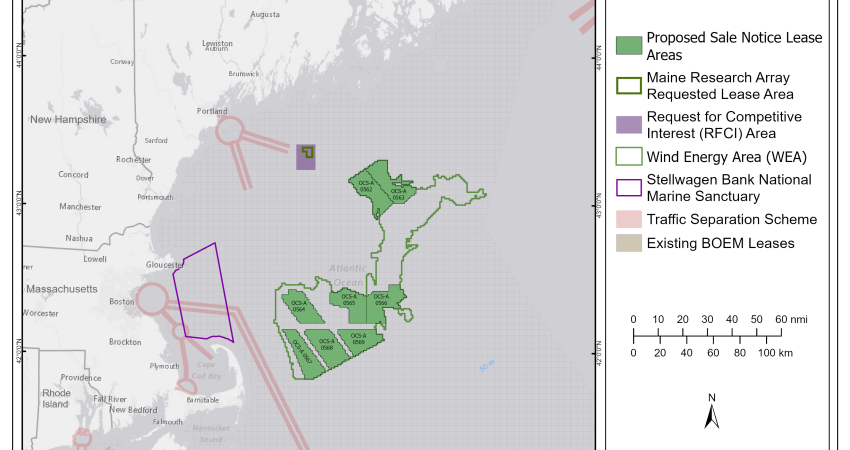Wind power developers Avangrid and Invenergy offered $21.9 million in winning bids for the first four offshore tracts in the deepwater Gulf of Maine federal waters, the Bureau of Ocean Energy Management said Tuesday.
Maine state official and energy planners see offshore wind energy as a major source by mid-century, but the technology and port infrastructure for floating wind turbines are still far off. Nevertheless Avangrid Renewables, LLC and Invenergy NE Offshore Wind, LLC are provisional winners for tracts east of Massachusetts and south of Maine.
Avangrid won Lease OCS-564 at $4.92 million for 98,565 acres, and Lease OCS-568 at $6.24 million for 124,897 acres, all lying about 29.5 nautical miles offshore.
Invenergy will get Lease OCS-562 for $4.89 million, consisting of 97,854 acres about 46.2 nm off Maine, and Lease OCS-567 for $5.88 million, covering 117,780 acres about 21.6 off Massachusetts.
If fully developed, the lease areas could potentially generate maximum energy outputs to supply 2.3 million homes, according to BOEM.
“To ensure we got the process of bringing offshore wind to the Gulf of Maine right, we’ve engaged in over a hundred outreach efforts with local communities and connected with thousands of partners and stakeholders,” BOEM Director Elizabeth Klein said in announcing the bids.
“Despite the general uncertainty around the upcoming presidential election, this is a vote of confidence for an American industry that has already received nearly $3 billion of new supply chain investment in the first nine months of 2024,” said Liz Burdock, president and CEO of the wind industry group Oceantic Network.
Commercial fishermen are not sharing that optimism, according to Jerry Leeman, CEO of the New England Fishermen's Stewardship Association.
"The government put our livelihoods and our coastal communities up on the auction block,” Leeman said Tuesday. “The areas slated for industrialization cover prime, multi-generational fishing grounds that will likely close forever, jeopardizing our ability to make a living and support partner businesses on shore.”
“Moreover, as we have previously explained, the six development sites in the southern gulf will effectively block safe access to much of Georges Bank,” said Leeman, who also predicts that fishermen will be displaced, putting more pressure on New England fishing grounds.
“We anticipate fishermen will congregate in the western gulf once development is underway, introducing unwelcome pressure to our nearshore fisheries.”
BOEM and wind companies are working to develop deepwater sites off the U.S. West Coast as well – although Oregon state officials, fishermen and Native tribes are resisting the leasing process there. BOEM says the Gulf of Maine lease sales “will support development of floating offshore wind in deep water sites,” while the Biden administration works with an interagency task force “to position the United States as a leader on these new technologies.”
The Oct. 29 bidding included over $5.4 million bidding credits, representing “binding commitments by companies to invest over $2.7 million in workforce training and domestic supply chain development, and an additional $2.7 million for fisheries compensatory mitigation,” according to the agency.
Next steps in the leasing process called for developers to submit their project plans for BOEM review, followed by BOEM developing environmental impact statements for analysis before construction and operations plans are submitted.







